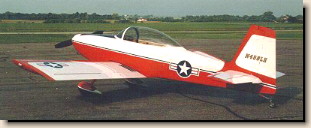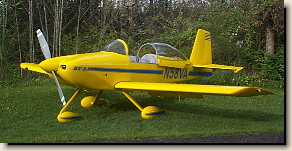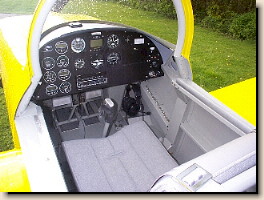|
In 1995, Van�s decided
to re-visit the tandem concept. Even though the side-by-side
RV-6/6A had become the most popular homebuilt design
ever, there was still a significant percentage of
pilots who really wanted centerline seating.
The consensus seemed to be that a new tandem airplane,
optimized for cross-country flying, would be popular.
 Apply For An adClix WebSite Sponsorship
Apply For An adClix WebSite Sponsorship
The "concept airplane"
was dubbed the RV-8. A one-of-a-kind demonstrator
was built in 1995 and introduced at Oshkosh. The cockpit
was several inches wider than the RV-4, so space both
front and rear was greatly improved. Really big people
(high on the "bubba scale") who could not
fit in earlier RVs now had an airplane they could
fly. A front baggage compartment almost doubled the
available baggage capacity�and along with the usual compartment behind
the rear seat, actually gave slightly more space than
the RV-6/6A. With compartments both forward and aft,
keeping the loaded airplane in the allowable CG envelope
was easier than ever. An upright seating position
under a big bubble canopy continued the RV tradition
of unparalleled visibility. Fuel capacity was increased
again and the engine compartment was designed to accept
engines from 150-200 horsepower.
capacity�and along with the usual compartment behind
the rear seat, actually gave slightly more space than
the RV-6/6A. With compartments both forward and aft,
keeping the loaded airplane in the allowable CG envelope
was easier than ever. An upright seating position
under a big bubble canopy continued the RV tradition
of unparalleled visibility. Fuel capacity was increased
again and the engine compartment was designed to accept
engines from 150-200 horsepower.
Although the wing looked
and flew exactly like the RV-4 wing, it was actually
much simpler to build. Advances in manufacturing and
design  capability,
including the acquisition of computer controlled machine
tools, meant that the entire kit could be simpler,
more precise and much more pre-fabricated than ever
before. capability,
including the acquisition of computer controlled machine
tools, meant that the entire kit could be simpler,
more precise and much more pre-fabricated than ever
before.
Performance was typically
RV. With the same power, the RV-8 flew and handled very
much like earlier RVs, but with the bigger engines, the
numbers were even more impressive. It was now possible
to maintain cruise speeds over 200 mph and climb rates
over 2500�/minute.
The response at Oshkosh
left no doubt about the desire for an airplane like
the RV-8. The ground around the display
aircraft was beaten into a trench and Van�s personnel
were turning down people waving handfuls of cash�but
not for too long. By December 1998, the complete kit
for the RV-8 was available. display
aircraft was beaten into a trench and Van�s personnel
were turning down people waving handfuls of cash�but
not for too long. By December 1998, the complete kit
for the RV-8 was available.
The RV-6A had
demonstrated that a trigear version was a necessity, and
in fact the trigear RV-8A had been planned from the
beginning. The prototype flew in early 1998, and kits
for both airplanes are now available. By the end of
1999, over 1100 builders (one per day since the airplane
went on sale!) had started RV-8s and about fifty
customer built airplanes were flying. It won�t be long
until many more are in the air.
|